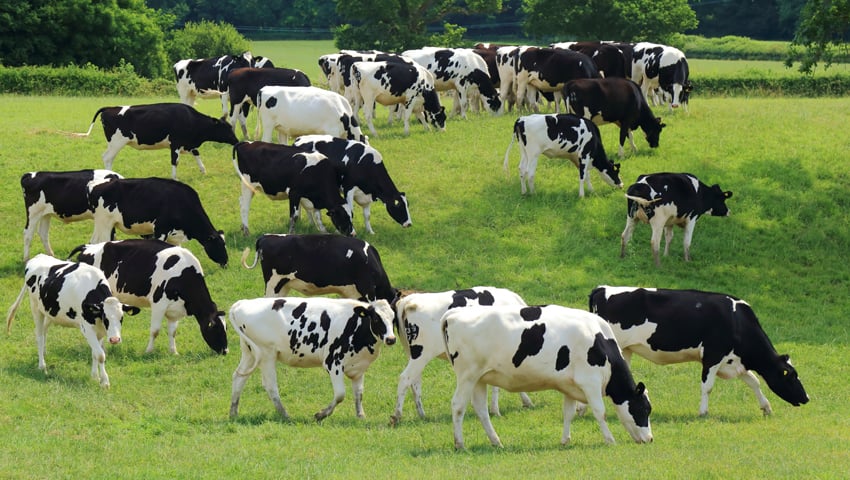A new report – Let’s get serious about making dairy regenerative – sets out a farmer-led vision for global regenerative dairy agriculture.
The Regen Dairy report is the culmination of a three year project, led by FAI Farms and Farmwel, which deployed a farmer-centric approach to better understand regenerative dairy: starting with the vision, the barriers, and the recommendations for transition.
Øistein Thorsen, FAI Farms’ chief executive, said, “We set out to find out from farmers how promoting biodiversity, soil health and climate resilience could be made an integral part of future dairy business models. What we heard was inspiring and actionable and has formed the backbone of this report’s roadmap towards regenerative dairy.”
The Regen Dairy report was launched this week at the Regenerative Agriculture Summit in Amsterdam by ffinlo Costain, the former chief executive of Farmwel, regenerative dairy farmer, Sophie Gregory, and Jo Lawrence from Arla.
The report identifies that many companies see regenerative agriculture as a method to deliver their net-zero roadmaps and Scope 3 emissions reduction targets. But, say the report authors, regen ag goes much further than pushing farmers to achieve low Scope 3 emissions at the farm level – it is recognised as a bottom-up movement that focusses on farmer-led change towards improving soils for increased crop growth and future resilience, promoting beneficial biodiversity to reduce the need for chemical inputs, enhancing farm economics and operating ethical businesses that support the health of animals, farm workers and local communities.
Regen Dairy researchers identified innovative regenerative farmers from the UK, USA, New Zealand, Africa and mainland Europe, who through interviews, became insightful dairy case studies. While these case studies showcase individual farmer experiences, they also helped to build an understanding of the common features of a regenerative approach.
Costain said, “We talked to farmers around the world to understand what regenerative dairy meant to them. We explored their journeys into regenerative farming and the opportunities and challenges they faced along the way. We also spoke to supply chain stakeholders to understand industry perspectives towards supporting the regenerative transition.
“Our farmer-led research was central to the Regen Dairy project. But moving forward, farmers cannot be expected to take on the challenges of regenerative transition alone. Support from every stage of the supply chain will be required for renewed social licence and business resilience to be achieved.”
The report draws together common elements from the farmer case-studies and defines regenerative dairy as “a whole system, context specific approach, it is about building resilient businesses that are economically sustainable because they focus on diversity and circularity. It utilises dairy cows as a tool within a diverse business to build and restore functional ecosystems, enhance biodiversity, improve water holding capacity and promote carbon sequestration, whilst producing a whole, nutrient rich food source. Ultimately regenerative dairy means healthy soils, healthy animals, healthy people and healthy communities.”
The Regen Dairy report also uses ‘personas’, a data-led social sciences approach, to create fictional characters that represent eight farming character archetypes.
Using these personas – for example, Michael, the status quo farmer, Lena, the information blocked farmer or Rachel, the young tenant farmer – the report outlines risks, opportunities and goals to help illustrate pathways for different farmers to make regenerative change.
To help visualize what regenerative dairy can look like in the real world the report writers created an idealised model for a regenerative dairy farm.
The report says, “A regenerative dairy system is circular, and milk is no longer the sole product. Calves born from dairy cows are kept on farm to produce pasture fed beef from herbal leys and within agroforestry/silvopasture systems. Fruit and nuts are also produced, not only providing additional revenue but providing shade in fields and creating diverse underground networks via their roots.
“Trees are also used along cow tracks to provide shade and as carbon sequesters. Dairy cows graze diverse pastures which help support underground microbial communities and draw down carbon whilst converting a human non-digestible crop into a nutrient dense product for the local community. Arable crops are grown on-farm in rotation using regenerative principles and without chemical fertilisers, pesticides or herbicides, the diversity within these arable systems ensures that the soil supports healthy plants which are multi-cropped, producing food for humans as well as dairy cows. The farm is protected from price shocks for fuel and feed, helping manage costs.
The report concludes with actions for key stakeholders, including for agri-food businesses, governments, landowners and farmers themselves.
It acknowledges that, “achieving food system change is a complex task and as such requires input and action from all stakeholders.”
It says, “farmers, agri-food companies, investors and governments must collaborate to build pragmatic outcome based incentivisation models that allow farmers to be rewarded for regenerative outcomes on farm.”
The Regen Dairy project was funded by industry stakeholders, Arla, Unilever, Woolworths South Africa, Ben & Jerry’s and Barry Callebaut.
Find out more at the Regen Dairy website
Look out for the Resources page, which hosts case studies, personas, training and links to webinars and podcasts produced in association with the Farm Gate podcast.
